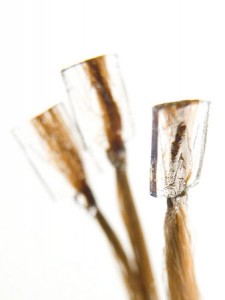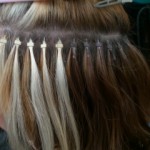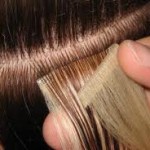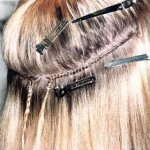Schedule an Appointment! (540) 786-4639
Hair Extensions Methods and Types
Strand by Strand
Small sectional pieces of hair are attached one by one to small sections of your own hair by using bonding (warm or cold), clamping, shrink tubing, micro tubes. Weaving or glue were and still are practiced but are older inferior methods of practice. These methods provide too much risk to your hair and will not be mentioned here.
Cold Fusion – Basically identical to Warm Fusion but the keratin bond is not warmed, but rather ultrasonic waves melt the Keratin to form the bond during installation. Cold Fusion as with Warm Fusion, bonds are removed with a special solvent, and tool.
Pros:
- Safest of all the extension materials
- Lightest of all extensions
- Safest and Healthiest for the hair

Keratin tipped Fusion Extension - virtually undetectable.
- Longest lasting method 3-6 months +
- New inventive installation technique
Cons:
- Most costly of all methods
- Virtually the same as Warm Fusion but for greater cost
- Time intensive installation
Warm Fusion – A small amount of Keratin, or other organic material is pre-attached or utilized on the ends of a strand. The extension strands are then attached to small sections of your hair near the scalp by warming the Keratin and forming a small bond to your hair. The site of attachment is so, that the extensions can move naturally with your own hair. These extensions last 3 – 6 months or more, and should be removed or redone at that time.
Pros:
- Same as Cold Fusion except for the installation technique
- A few systems are re-useable
Cons:
- Most costly of all methods with the exception of Cold Fusion.
- Time intensive installation
Links, Microlinks, Beads, Tubes, Rings, or Locks – Strand to Strand technique where the extension hair strand and your hair is put through a small tube which is then squeezed shut with a special tool in order to attach the extension to your hair.

- Less expensive than Fusion techniques
- slightly less time consuming installation compared to the Fusion method.
- Micro-beads can be moved up when they slip down the hair shaft.
- Longer lasting method than Weft systems.
Cons:
- Heavier and more readily seen when compared to the other Fusion methods.
- M-Links\ tubes are hard metallic materials and can be uncomfortable against the scalp for some especially when lying down.
- Micro Links frequently slip down the hair shaft and need constant readjustment.
- M-Links contain grooves similar to a screw, and this can cause friction which can damage the hair shaft, when Mlinks are clamped together.
Scalp attached extensions – The Extension is a skin replica. An air tight, water tight seal is created allowing 5-8 weeks of attachment. “Skin” base is adhered directly to your scalp by the use of an medical grade adhesive. Note that this method is just being mentioned because it is a hybrid of the Strand by Strand method.

Weft Hair Extensions
A weft is a track several inches long on which the hair is attached (a swathe of hair is attached together at the top and freely hanging at the bottom). A weft can be man-made or created by machine. The extensions are then applied by using one row (track) at the time instead of strand by strand. Methods of attachment of Wefts consists of Micro Rings, Tape, Glue , and sewing to your hair.
Micro-Rings – A weft is located on a divided section of the client’s hair. Two strands (one from the scalp and another from the weft) are joined and pulled through a micro ring, which is then flattened. This way the weft is attached by fitting together several strands both from the weft and the scalp.
Taped Hair extensions – also called skin weft, is a relatively newer technique. Hair is held together by double transparent sided polyurethane tape. One piece of the tape is torn off and the weft is applied the scalp. The weft and the attached hair is pulled upwards and another weft is attached underneath. That way the client’s hair section is surrounded by two wefts.
Glued Hair Weft Extensions – Glue It is simply applied to the sewed part of the weft and then fitted on the client’s hair.
Sewed in or Braided Wefts- client’s hair is braided, making either one spiral cornrow, which covers the whole head, or several straight ones which match the layering. After this has been done, the wefts are sewn into these cornrows
Pros:
- Installation time is much faster than the Strand by Strand method.
- Weft Attachment methods consist of sewing to original hair, taping, beads, clips etc.
- Less costly than Strand by Strand
- Installation time is much faster than any Strand by Strand technique

Cons:
- Stress Hair much more than Strand extensions. Significant more weight per hair than Strand method
- Weft extensions utilizing Tape creates excessive residue, and makes it difficult to remove extensions without pulling out some of your own hair. (some tape brands claim to limit residue)
- Some people have allergic reactions to the tape adhesive used.
- Glue and braids are pretty much old-school applications, and these applications as we have experienced can cause the most damage to your hair.
- Weft Hair extensions are more visible to the human eye compared to Strand by Strand some tpes show less than others.
- Maintenance intensive, needs readjustments.
Clip on Extensions – are the shortest term temporary solution in which you use on a day to day basis, and remove them before retiring for the evening. Some clip on extensions come with Remy Hair.
Hair types:
Remy hair is considered the best hair available since it’s structure resembles real hair with the cuticle intact, and flowing in the same direction. Other non-Remy Hair types are processed with silicon and the cutlicle is removed. This treated hair has tendency of tangling, drying out, matting, and oxidizing much quicker. With other hair you will never approach the natural looks you get with Remy hair. Finally there is synthetic hair. Technology is ever improving the quality of synthetic hair, but as of this day Synthetic hair still does not come close to the looks and feel of real hair, blending of the hair is a real issue with Synthetic hair. So for a bit more money your extensions will look better last longer and require less maintenance if you use Remy hair.
Don’t skimp on the Consultation:
If you are interested in getting Hair extensions, recommended practice would be to check your local Salons and see what attachment methods they specialize in. Hair Extensions as mentioned previously may not be the timely solution for everyone, so an anticipated Hair Extension appointment should start with a thorough consultation. If your Stylist is pressuring you in getting started right away without giving you a detailed consultation encompassing your Hair’s Health, your Expectations, Maintenance and upkeep required, and other factors surrounding Hair Extensions, then it might be time to start to look for another Salon. Remember the consultation is an opportunity for you to interview your Stylist and gain trust before you have work done, so ask away!
